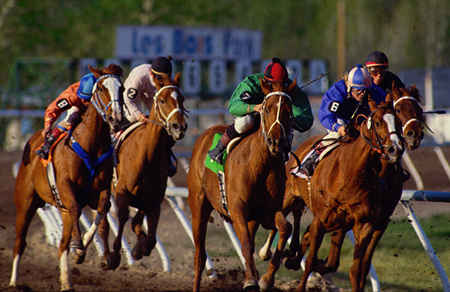Horse Betting History
Horses and man have been working together since the time nomadic tribesmen living on the barren steppes of Central Asia domesticated the ancestors of today�s thoroughbreds over 6000 years ago. Surely the power and speed a rider experiences on a galloping charger incited races long before man ever put pen to paper to record his thoughts, or his bets. Homer tells of funerary chariot races following the death of Patroclus in the Iliad and mounted horse races are recorded in the records of the Ancient Olympics, indicating that its history undoubtedly stretches much further back in time. In the Roman Empire chariot and mounted horse racing were major industries with breeding programs, imported bloodlines, exhaustive training routines, and all the accoutrements of organized wagering: horse-racing tracks, bookmakers, hot tips, scandals, and, most of all, excitement. The decline of the Roman Empire also saw a decline in organized public racing until well into more modern times.Today�s racehorses are thought to be descendants of Arabian stallions brought back from the Middle East during the Crusades in the 11th through 14th centuries and bred with the sturdy mares of England to produce faster horses that could carry weight over greater distances. It became popular for knights and royalty to wager on races between two horses over a private course or an open field and King Charles II of England (1660-1685) was an early supporter, helping the nickname �The Sport of Kings� come to being. This �match racing� inspired new interest in breeding and ultimately the thoroughbred lines known today can trace their male lines all the way back to three stallions from the 17th and 18th centuries:
The Byerly Turk (1680-1696) Captured from the Turks in Hungary, he was brought to England by Colonel Robert Byerley. Due to a printer's error, the horse's name was registered in the General Stud Book without the final "e."
The Godolphin Arabian (1724-1753) Given by the Bey of Tunis to the King of France, he was purchased by Edward Coke and subsequently presented to the Earl of Godolphin, at whose stud he sired the champion mare Aelima, imported to Maryland in 1750.
The Darley Arabian (1700-1733) Thomas Darley sent this Arabian stallion from Syria to England. Ninety percent of all Thoroughbreds today are descended through his son Flying Childers and his great-great grandson Eclipse. (The Eclipse Awards that honor champion horses in a wide variety of categories on an annual basis are named after this horse.)

This growth required regulation and in 1750 The Jockey Club was established in Newmarket, England to organize a complete set of rules and standards, including pedigree. The Club commissioned the Introduction to the General Stud Book to trace the bloodlines of all the horses racing in England in 1791. All 387 mares listed in the first volume of the General Stud Book trace back to the three founding sires The Byerly Turk, The Godolphin Arabian, and The Darley Arabian. Soon only horses called �Thoroughbreds� that were descended from horses listed in the General Stud Book were allowed to race.
Horse racing in the United States is directly tied to British colonization and the first American horse race track was laid out on Long Island in 1665. Governor Sam Ogle of Maryland is credited with organizing regulated racing when, in 1745, races were held in Annapolis "between pedigreed horses, in the English style". Quality British racers were imported and breeding programs began in earnest but were decimated by the Revolutionary War between the American Colonists and the British, the source of racing/breeding horse stock. New breeding stock was introduced after the war and breeding programs flourished in the United States, particularly in the Southern states. The American Civil War, one of the last major wars with horses as the primary transport and attack vehicles, once again wiped out much of the American breeding stock but the comeback was tremendous. The American Stud Book began in 1868 and by 1890 314 horse race tracks were operating throughout the country. The American Jockey Club was established in 1894 to control the racing industry and today still maintains authority over the breeding of thoroughbreds.
The turn of the 20th century saw significant declines in horseracing due to conservative political attitudes that led to the banning of bookmaking (the primary horseracing betting system known at the time) in almost every state. The number of tracks dropped to 25 by 1908. In that year pari-mutuel wagering was introduced for the Kentucky Derby. This betting system allows much closer regulation and easier taxation, making horseracing very lucrative to individual states that were free to create racing commissions and regulate their own state tracks as they saw fit, unseating the non-governmental American Jockey Club.
Horse racing flourished under state control up through the 1950�s and saw a major decline in the 60�s before a resurgence in the 1970�s, primarily attributed to the Triple Crown performances of Secretariat, Seattle Slew, and Affirmed. Today most public interest in the US surrounds the three Triple Crown races (Kentucky Derby, Preakness Stakes, and Belmont Stakes) and the Breeder�s Cup. These races have purses of 1 million or more and attract huge television audiences. Track attendance in general is significantly lower than the peaks reached in the middle of the 20th century but there is continued growth in wagering due to increasingly available off track betting establishments and simulcasting. Now Internet wagering has The Sport of Kings off and running in ways never imagined.
